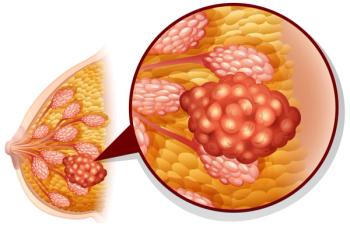
Second Line PARP Maintenance May Increase Overall Survival vs Active Surveillance in Ovarian Cancer
Patients with recurrent ovarian cancer experienced a longer overall survival and time to next treatment when receiving second-line PARP maintenance compared with active surveillance.
Treatment with a second-line PARP maintenance therapy in the second line resulted in a longer overall survival (OS) and time to next treatment compared with active surveillance, according to a poster presentation at
The median OS in the overall population who received PARP inhibitors was 26.4 months (95% CI, 21.3-34.4) compared with 16.7 months (95% CI, 15.1-19.6) in the active surveillance group (HR, 0.66; 95% CI, 0.56-0.76). In the population with BRCA mutations, investigators reported a median OS of of 47.1 months (95% CI, 26.4-47.1) vs 43.8 months (95% CI, 22.3–not reached) in the PARP inhibitor and active surveillance groups, respectively. In the BRCA wild-type population, the median OS was 23.2 months (95% CI, 20.4-34.4) vs 16.7 months (95% CI, 15.1-19.6) in both respective groups.
A total of 936 patients enrolled on the trial, 198 of whom received PARP inhibitors and 747 underwent active surveillance. The median overall age was 68.0 years, and the majority of patients were White (72%) and receiving treatment at community practices (86%). Most patients had BRCA wild-type disease (76%), and others had BRCA mutations (11%). In terms of histology, 78% of patients had serous disease; 14% had disease that was epithelial, not otherwise specified, or unknown; and 8% had clear cell, endometrioid, mucinous, or transitional cell cancer.
Exclusion criteria included those with an incomplete medical history, borderline histology, or treatment with a non-PARP inhibitor therapy within 120 days of the index date, as well as those who received PARP inhibitor monotherapy as a first- or second-line treatment. Inclusion criteria included those receiving PARP inhibitor therapy within 120 days after index or would be relegated to the active surveillance group if not.
The median follow-up was 14.2 months for the PARP inhibitor group compared with 6.7 months in the active surveillance group.
After debulking surgery for initial diagnosis, 50% of patients receiving PARP inhibitors had no visible residual disease compared with 34% of those receiving active surveillance. Similar findings were reported among patients with a BRCA mutation (21% vs 8%) and those with an ECOG performance status of 0 to 1 (79% vs 69%) who received PARP maintenance and active surveillance, respectively. Of those who were treated with PARP inhibitors, 33% received single-agent niraparib (Zejula), 34% received single-agent olaparib (Lynparza), 16% received single-agent rucaparib (Rubraca), and 16% received other regimens such as bevacizumab (Avastin) plus a PARP inhibitor or PARP inhibitor polytherapy.
The median time to next treatment in the overall population was 6.4 months (95% CI, 5.6-7.1) in the PARP inhibitor group and 3.3 months (95% CI, 2.7-4.0) in the active surveillance group (HR, 0.73; 95% CI, 0.68-0.79). Those with a BRCA mutation had a median time to next treatment of 13.2 months (95% CI, 10.3-22.1) vs 7.1 months (95% CI, 5.2-9.9) in the PARP inhibitor and active surveillance groups, respectively. Those who were BRCA wild-type had a median time to next treatment of 5.8 months (95% CI, 4.8-6.7) vs 2.8 months (95% CI, 2.3-3.5) in both respective groups.
Reference
Matulonis U, Mirza M, Malinowska I, et al. Real-world clinical outcomes with poly (adenosine diphosphate [ADP]-ribose) polymerase inhibitors as second-line maintenance therapy in patients with recurrent ovarian cancer in the United States. Presented at The Society of Gynecologic Oncology Annual Meeting on Women’s Cancer; March 18-20, 2022; Phoenix, AZ. Poster 353.
Newsletter
Stay up to date on recent advances in the multidisciplinary approach to cancer.



















































































